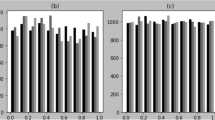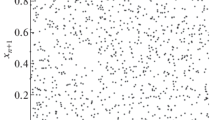Abstract
In an earlier paper, cf. [7], the first author developed methods for evaluation of pseudo-random number generators based on ideas of computer simulation. More precisely, pseudo-random numbers of the tested generator are used to model certain distributions which can be compared with theoretical ones or with distributions modeled by means of well-known canonical generators. But this method can fail if essentially different generators produce simulations that cannot be distinguished by means of simple statistical tests developed in [7]. In the present paper two critical types of distributions, named geometric and arthmetic, are constructed that illustrate the circumstances above. Also it is shown how the subinterval method derived from the tests in [7] can serve to detect the described critical types of distributions. Additional aspects of old and new methods are shortly discussed.
Zusammenfassung
In einem früheren Artikel, vgl. [7], hat die erste Autorin Bewertungsmethoden von Pseudozufallsgeneratoren entwickelt, die auf Ideen der Computer-Simulation basieren. Dabei werden die Pseudozufallszahlen des getesteten Generators zur Modellierung gewisser Verteilungen herangezogen. Diese kann man mit theoretischen Verteilungen oder mit Verteilungen, die mittels wohlbekannter kanonischer Generatoren modelliert werden, vergleichen. Obige Methode kann aber versagen, falls wesentlich verschiedene Generatoren die Simulationen ausführen, welche mit Hilfe unserer einfachen Tests nicht auseinandergehalten werden können. In diesem Artikel werden Typen von kritischen Verteilungen konstruiert, die geometrisch bzw. arithmetisch gennant werden und durch bestimmte Bedingungen dargestellt werden. Es wird darauf hingewiesen, wie die Teilintervall-Methode, welche von den in [7] eingeführten Tests hergeleitet wird, zur Aufdeckung der kritischen Verteilungstype angewendet werden kann. In zusätczlichen Bemerkungen werden noch weitere Anwendungsaspekte unserer Bewertungsmethode betrachtet.
Similar content being viewed by others
Explore related subjects
Discover the latest articles, news and stories from top researchers in related subjects.References
Boros, I., Niederreiter, H.: Optimal multipliers for pseudo-random number generation by the linear congruential method. BIT23, 65–74 (1983).
Gel'fond, A. O.: Isčislenie Konečnyh Raznosteî. Moskva: ‘Nauka’ 1967.
Knuth, D. E.: The art of computer programming, vol 2. Seminumerical algorithms, 2nd ed. Reading: Addison-Wesley 1981.
MacLaren, M. D., Marsaglia, G.: Uniform random number generators. J. Assoc. Comp. Mach.12, 83–89(1965).
Nielsen, N.: Traité Élémentaire des Nombres de Bernoulli. Paris: Gauthier-Villars 1923.
Ugrin-Šparac, G.: On a distribution encountered in the renewal process based on uniform distribution. Glasnik Mat. Ser III25, 221–233 (1990).
Ugrin-Šparac, G.: Stochastic investigations of pseudo-random number generators. Computing46, 53–65 (1991).
Ugrin-Šparac, D.: Problem of uniqueness in the renewal process generated by the uniform distribution. J. Appl. Math. Stoch. Anal. (JAMSA)5, 291–306 (1992).
Ugrin-Šparac, D.: A possible standard simulation of natural stochastic uniform distribution (in preparation).
Author information
Authors and Affiliations
Rights and permissions
About this article
Cite this article
Ugrin-Šparac, G., Ugrin-Šparac, D. On a possible error of type II in statistical evaluation of pseudo-random number generators. Computing 56, 105–116 (1996). https://doi.org/10.1007/BF02309340
Received:
Revised:
Issue Date:
DOI: https://doi.org/10.1007/BF02309340




